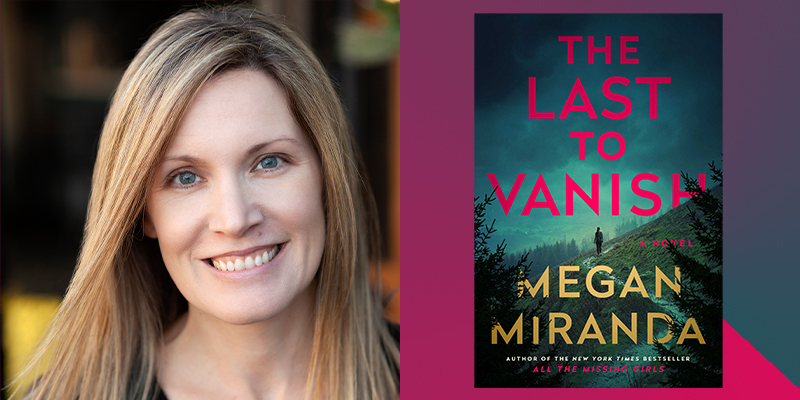Megan Miranda is known for her twisty psychological thrillers, atmospheric settings, and deep insight into the psychology of her characters. I’ve been a fan ever since I picked up her second book, The Perfect Stranger, and Megan Miranda’s latest continues to cement her reputation as a writer at the top of her field. In Miranda’s latest slow-burn suspense, The Last to Vanish, a small town is the setting for a series of disappearances against a dramatic mountain backdrop. Megan Miranda was kind enough to answer a few questions about craft, setting, and the art of building suspense.
Molly Odintz: One of the themes of the novel is that small towns change their residents; newcomers gradually conform to the ways of their neighbors or find themselves shut off from community life. What did you want to explore about small towns?
Megan Miranda: Cutter’s Pass is a place that owns its history, and keeps its secrets. But for that reason, you’re only fully trusted if you’re fully on the inside, with as much at stake as everyone else. To become home, that’s the tradeoff. I try to approach settings the same way I approach characters—in that a setting will have its own unique history, and its own way of interacting with the rest of the world. I also believe that there’s a duality in every setting, and that the same place can be both beautiful and terrifying in the same moment, depending on the perspective of each character. I thought of the town of Cutter’s Pass as a force: the more you carve out a place for yourself there, the more it changes you in return. And the question instead becomes: Are you sure that’s what you really want?
MO: Nature’s drama plays a starring role in the book. Are you an avid hiker? What research did you do into the novel’s natural environment?
MM: My parents were (and still are) avid hikers. So up until adulthood, I would say I was the same. Every summer vacation was spent hiking, anywhere from Virginia to Maine. But as I got older, I let it go. Like a lot of things, it was something I came back to in adulthood in a different way—when I had my own children, in a way that now seems full circle. A few Christmases ago, my parents bought me a new pair of hiking boots, and it felt like a sign: Welcome back. It’s not an activity that features as prominently in my life as it did when I was younger, but it’s a huge source of so many of my family memories—and we’ve done some three-generation hikes over the last few years as well. If I were to pick an avid hiker in our household now, I’d say it’s my husband. Like Abby in the book, I only do shorter day hikes, but he does some backpacking—so he was a great resource as well. When I was writing this book, we stayed at various inns and bed-and-breakfasts located very close to the Appalachian trail in North Carolina and Virginia, exploring the area in different seasons. I get a lot of inspiration from place, so it was a huge help to get to spend some more time there.
MO: Many of the town’s visitors are drawn by its dark past, a fact that makes locals uneasy, although still willing to make a profit. What are your thoughts about dark tourism?
MM: This was something I was thinking about while writing, and one of the inspiration points for the story itself. My teens had gone on a few historical ghost tours, and I started thinking about a place with a notorious history that had occurred very recently instead—and a town that embraces that history as part of their identity. I wanted to explore all the facets of that, and I think that’s reflected in reality as well. There’s always a duality. In Cutter’s Pass, there’s that lingering question of the line between mystery and tragedy—and the realization that they’re often both at the same time. I try not to approach themes in my books with an answer in mind, but a question to explore, and to see it through the eyes of different characters and motivations and experiences.
MO: Your books play often with the ideas of vanishing and reinvention. What draws you to the idea of characters with unstable, shifting identities or those who’ve disappeared?
MM: There are some themes I’m drawn to over and over, and yes, this is definitely one of them. Just like in the prior question, I see these themes as questions to explore. A disappearance leaves so much open-ended: the mystery is not only in the how or why, but the Is it a choice, an accident, a crime? Are people who we thought they were? Can you ever escape the past and become somebody new? I think I’m drawn to these questions and storylines because I think the heart of most mysteries is about what exists inside other people.
MO: As a writer known for your use of suspense, what’s the key to creating slow-burn tension?
MM: That’s a great question. For me, I try to see the tension within every relationship or situation, in addition to the plot. The interpersonal dynamics, the push and pull within the narrator, the choices they have to make—everything adds to that sense of rising suspense. When a character is afraid, everything takes on an element of danger. There’s a general atmosphere of uncertainty in everything, including the people they thought they knew. Things they once loved about the setting can turn menacing instead. I try to use it all, to build that lasting suspense alongside the plot.
MO: What’s on your nightstand?
MM: My nightstand is currently overflowing with books I’m looking forward to reading! At the moment, I’m reading and loving I’ll Be You be Janelle Brown. And I’m so excited to dive into Jennifer Hillier’s Things We Do in the Dark.
***


















